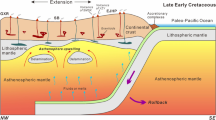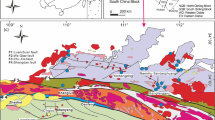Abstract
Apparent crustal residence ages indicated by Nd model age data for metamorphic rocks, sediments and granitoids of the Hercynian Fold Belt of Europe vary from 1.3 Ga to 3.0 Ga, but are mainly in the range 1.4–1.7 Ga. 2 Ga basement inliers have been documented previously in northern Spain and islands off northwestern France but, in addition to these, old (∼2–3 Ga) model ages are found along the southern margin of the fold belt. These do not identify old inliers but are interpreted to represent Archeanearly Proterozoic crustal components recycled from a southern source. The Nd data, when considered together with the surface geology and recent single-grain zircon ion microprobe data, argue against a binary mixing of Archean components with new Palaeozoic crustal additions to generate the main 1.4–1.7 Ga model age population. Hercynian Europe comprise mainly recycled Proterozoic components although significant new Palaeozoic additions as well as Archean contributions are indicated.
Nd and Sr isotopic data together with previous chemical and petrographic observations allow the recognition of a northern belt of continent margin I-type granitoids grading southwards to inner continent S-type plutons in the eastern half of the fold belt. This felsic plutonic association is used to infer a Hercynian plate configuration involving the attachment of the fold belt to a southern parent cratonic block that the model age data suggest may be of early Proterozoic-Archean age.
Similar content being viewed by others
References
Allègre CJ, Ben Othman D (1980) Nd-Sr isotopic relationship in granitoid rocks and continental crust development: a chemical approach to orogenesis. Nature 286:335–342
Anderson TA (1975) Carboniferous subduction complex in the Harz Mountains, Germany. Bull Geol Soc Am 86:77–82
Badham JPN (1982) Strike-slip orogens — an explanation for the Hercynides. J Geol Soc London 139:493–504
Behr HJ, Engel W, Franke W, Giese P, Weber K (1984) The Variscan Belt in central Europe: Main structures, geodynamic implications, open questions. Tectonophysics 109:15–40
Ben Othmann D, Fourcade S, Allègre CJ (1984) Recycling processes in granite-granodiorite complex genesis: the Querigut case studied by Nd-Sr isotope systematics. Earth Planet Sci Lett 69:290–300
Bernard-Griffith J, Peucat JJ, Sheppart S, Vidal Ph (1985) Petrogenesis of Hercynian leucogranites from the Southern Armorican Massif: Contribution of REE and isotopic (Sr, Nd, Pb and O) geochemical data to the study of source rock characteristics and ages. Earth Planet Sci Lett 74:235–250
Brewer MS, Lippolt HJ (1974) Petrogenesis of basement rocks of the Upper Rhine region elucidated by Rb-Sr systematics. Contrib Mineral Petrol 45:125–141
Collins WJ, Beams SD, White AJR, Chappell BW (1982) Nature and origin of A-type granites with particular reference to southeast Australia. Contrib Mineral Petrol 80:189–200
Davies G, Gledhill A, Hawkesworth C (1985) Nd and Sr isotope studies bearing on the crustal evolution of southern Britain. Earth Planet Sci Lett 75:1–12
DePaolo DJ (1981) A ND and Sr isotopic study of the Mesozoic calc-alkaline batholiths of the Sierra Nevada and Peninsular Ranges, California. J Geophys Res 86:10470–10488
Downes H, Leyreloup A (1986) Granulitic xenoliths from the French Massif Central — petrology, Sr and Nd isotopic systematics and model age estimates. In: The Nature of the Lower Continental Crust. (Eds: Dawson JB, Carswell DA, Hall J, Wedepohl KH). Geol Soc Lond Spec Pub 24:319–330
Emmermann R (1977) A petrogenetic model for the origin and evolution of the Hercynian granite series of the Schwarzwald. N Jb Mineral Abh 128:219–253
Finger F, Höck V (1985) Zur Geochemie von S-typ Granitoiden aus dem westlichen oberösterreichischen Moldanubikum. Fortschr Mineral 63:280
Floyd PA (1982) Chemical variation in Hercynian basalts relative to plate tectonics. J Geol Soc London 139:505–520
Fluck P (1980) Les granitoides des Vosges. In: Autran A, Dercourt J (eds) Evolutions géologiques de la France. Mémoire du BRGM 107:83–86
Fluck P, Maass R, von Raumer JF (1980) The Variscan Units east and west of the Rhine graben. Colloque C6: Geology of Europe, from Precambrian to post-Hercynian sedimentary basins. Mémoire du BRGM 108:112–131
Gebauer D, Grünenfelder M (1977) U-Pb systematics of detrital zircons from some unmetamorphosed to slightly metamorphosed sediments of central Europe. Contrib Mineral Petrol 65:29–37
Gebauer D (1986) The development of the continental crust of the European Hercynides since the Archean based on radiometric data. Proceedings of the 3rd workshop on the European Geotraverse Project. 15–23
Grauert B, Hänny R, Soptrijanova G (1974) Geochronology of a polymetamorphic and anatectic gneiss region: The Moldanubicum of the area Lam-Deggendorf, E. Bavaria, Germany. Contrib Mineral Petrol 45:37–63
Grünenfelder MH; Williams IS, Compston W (1984) Use of the ion-microprobe in deciphering complex U-Th-Pb systems in zircons from the pre-Alpine basement, Switzerland. Terra Cognita Spec. Vol ECOG VIII: 26–27
Guerrot C, Peucat JJ, Capdevila R (1987) The oldest granulitic crust involved in the Hercynian Belt: Preliminary U-Pb and Sm-Nd data. Abst Vol EUG IV Strasbourg, Terra Cognita 7:159
Hensel HD, McCulloch MT, Chappell, BW (1985) The New England Batholith: constraints on its derivation from Nd and Sr isotopic studies of granitoids and country rocks. Geochim Cosmochim Acta 49:369–384
Hoefs J, Emmermann R (1983) The oxygen isotope composition of Hercynian granites and pre-Hercynian gneisses from the Schwarzwald, SW Germany. Contrib Mineral Petrol 83:320–329
Hofmann AW (1979) Geochronology of the crystalline rocks of the Schwarzwald. In: Jäger E, Hunziker JC (eds) Lectures in Isotope Geology. Springer Berlin Heidelberg New York, pp 215–221
Kober B, Lippolt HJ (1985) Pre-Hercynian Pb transfer to basement rocks as indicated by Pb isotopes of the Schwarzwald crystalline, SW Germany, I+II. Contrib Mineral Petrol 90:162–178
Köppel V, Günthert A, Grünenfelder M (1980) Patterns of U-Pb zircon and monazite ages in polymetamorphic units of the Swiss Alps. Schweiz Mineral Petrogr Mitt 61:97–119.
Kreuzer H, Harre W (1975) K/Ar Altersbestimmungen an Hornblenden und Biotiten des kristallinen Odenwaldes. In: Amstutz GC, Meisl S, Nickel E (eds) Mineralien und Gesteine im Odenwald. Aufschluß, Sonderband 27 (Odenwald), Heidelberg
Liew TC, McCulloch (1985) Genesis of granitoid batholiths of Peninsular from a Nd-Sr isotopic and U-Pb zircon study. Geochim Cosmochim Acta 49:587–600
Lorenz V, Nicholls IA (1984) Plate and intraplate processes of Hercynian Europe during the late Palaeozoic. Tectonophysics 107:25–56
McCulloch MT, Chappell, BW (1982) Nd isotopic characteristics of S- and I-type granites. Earth Planet Sci Lett 58:51–64
McCulloch MT, Wasserburg GJ (1978) Sm-Nd and Rb-Sr chronology of continental crust formation. Science 200:1003–1011
Mecklenburg S, Vinx R, Baumann A (1985) Altersbestimmungen und Isotopenuntersuchungen an Harzer Magmatiten. Fortschr Mineral [Beih 1] 63:287
Michard A, Gurriet P, Soudant M, Albarède F, (1985) Nd isotopes in French Phanerozoic shales: external vs internal aspects of crustal evolution. Geochim Cosmochim Acta 49:601–610
Miller CF, Bradfish LJ (1980) An inner Cordilleran belt of muscovite-bearing plutons. Geology 8:412–416
Okrusch M (1983) The Spessart Crystalline Complex, northwest Bavaria (Excursion Guida). Fortschr Mineral [Beihe 2] 61:135–169
O'Nions RK, Hamilton PJ, Hooker, PJ (1983) A Nd isotope investigation of sediments related to crustal development in the British Isles. Earth Planet Sci Lett 63:229–240
Patchett PJ, Bridgwater D (1984) Origin of continental crust of 1.9-1.7 Ga age defined by Nd isotopes in the Ketilidian terrain of south Greenland. Contrib Mineral Petrol 87:311–318
Pitcher WS (1982) Granite type and tectonic environment. In: Hsu K (ed) Mountain Building Processes. Academic Press, London, pp 19–40
Richard P, Shimizu N, Allègre CJ (1976) 143Nd/146Nd, a natural tracer: An application to oceanic basalts. Earth Planet Sci Lett 31:269–278
Schleicher H (1978) Petrologie der Granitoporphyre des Schwarzwaldes. N Jb Miner Abh 132(2): 153–181
Stosch HG, Lugmair GW (1984) Evolution of the lower continental crust: granulite facies xenoliths from the Eifel, West Germany. Nature 311:368–370
Taylor SR, McLennan SM, McCulloch MT (1983) Geochemistry of loess, continental crustal composition and crustal model ages. Geochim Cosmochim Acta 47:1897–1905
Todt WA, Büsch W (1981) U-Pb investigations on zircons from pre-Variscan gneisses-I: A study from the Schwarzwald, West Germany. Geochim Cosmochim Acta 45:1789–1801
Van Breemen O, Aftalion M, Bowes DR, Dudek A, Misar Z, Povondra P, Vrána S (1982) Geochronological studies of the Bohemian massif, Czechoslovakia, and their significance in the evolution of central Europe. Trans Roy Soc Edinburgh: Earth Sc 73:89–108
Vitrac AM, Albarède F, Allègre CJ (1981) Lead isotope compositions of Hercynian granitic K-felspars constrain continental genesis. Nature 291:460–464
Wedepohl KH, Delevaux MH, Doe B (1978) The potential source of Pb in the Permian Kupferschiefer Bed of Europe and some selected Palaeozoic mineral deposits in the Federal Republic of Germany. Contrib Mineral Petrol 65:273–281
White AJR, Chappell BW (1983) Granitoid types and their distribution in the Lachlan Fold Belt, southeastern Australia. Geol Soc Am Mem 159:21–34
Windley BR (1977) The evolving continents. John Wiley & Sons, London pp 193–201
Ziegler PA (1984) Caledonian and Hercynian crustal consolidation of the European Alpine foreland. Terra Cognita 4:51–58
Author information
Authors and Affiliations
Rights and permissions
About this article
Cite this article
Liew, T.C., Hofmann, A.W. Precambrian crustal components, plutonic associations, plate environment of the Hercynian Fold Belt of central Europe: Indications from a Nd and Sr isotopic study. Contrib Mineral Petrol 98, 129–138 (1988). https://doi.org/10.1007/BF00402106
Received:
Accepted:
Issue Date:
DOI: https://doi.org/10.1007/BF00402106




